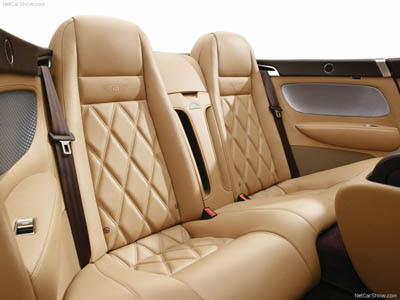

Jaguar Cars is adding even more appeal to the 'must have' XKR with the unveiling of the all-new special edition Portfolio model. The 4.2-litre supercharged sports car will be sold
The XKR's already powerful sporting styling cues - an enhanced front bumper, bonnet louvres and aluminium-finish grilles and side power vents - will remain and exclusive Celestial Black exterior paint and 20-inch polished Cremona five-spoke alloy wheels add to the overall presence.
The XKR's interior represents a truly sophisticated yet driver-focussed environment thanks to class-leading ergonomics, user-friendly in-car simple, clear information displays in the instrument panel and main dashboard area.
 The XKR Portfolio will combine this acclaimed
The XKR Portfolio will combine this acclaimed Now, to offer even greater braking ability, Jaguar's Special Vehicles has worked alongside leading brake manufacturer Alcon to create the largest, most powerful brakes a production Jaguar has ever carried. After extensive testing by experts at Jaguar's specialist engineering centre (which is based next to the legendary Nürburgring race circuit in Germany), the new XKR Portfolio braking system was conceived.
 400mm front brake discs - an increase of 45mm over the standard XKR - are retarded by powerful six-piston callipers, while at the rear four-piston calipers operate on 350mm discs.
400mm front brake discs - an increase of 45mm over the standard XKR - are retarded by powerful six-piston callipers, while at the rear four-piston calipers operate on 350mm discs. By allowing the heat created within the system to dissipate quickly and efficiently the XKR Portfolio's brakes produce fade-free performance whilst maintaining Jaguar renowned blend of refinement and stopping power. Unique 'R' branding on the front brake calipers reveals the six-piston set-up beneath.
Surrounding the XKR Portfolio's brakes are polished 20-inch five-spoke Cremona wheels, while behind the front wheels sit all-new Power Vents which are hewn from polished aluminium and incorporate the indicator side repeater and Jaguar signature 'ingot'. An exclusive Celestial Black exterior paint will also serve to differentiate the XKR Portfolio edition. (UK and
A host of new additions to the interior further the luxurious look and feel of the XKR Portfolio. A unique, and quite beautiful, Engine-Spun aluminium veneer is standard on the Portfolio, while customers will also have the option of an elegant Satin American Walnut veneer. A new alloy and
The XKR Portfolio also marks another first for Jaguar: the first production example of its new partnership with renowned audio
 Taking Jaguar's 525W Premium Audio system with Dolby Pro Logic II surround sound as a starting point, Bowers & Wilkins have crafted a signature speaker system specifically for the XKR's cabin. High-output, low-distortion Kevlar mid-range speakers and specially designed aluminium-dome tweeters deliver superb mid-range and extended high-frequency responses.
Taking Jaguar's 525W Premium Audio system with Dolby Pro Logic II surround sound as a starting point, Bowers & Wilkins have crafted a signature speaker system specifically for the XKR's cabin. High-output, low-distortion Kevlar mid-range speakers and specially designed aluminium-dome tweeters deliver superb mid-range and extended high-frequency responses.










































